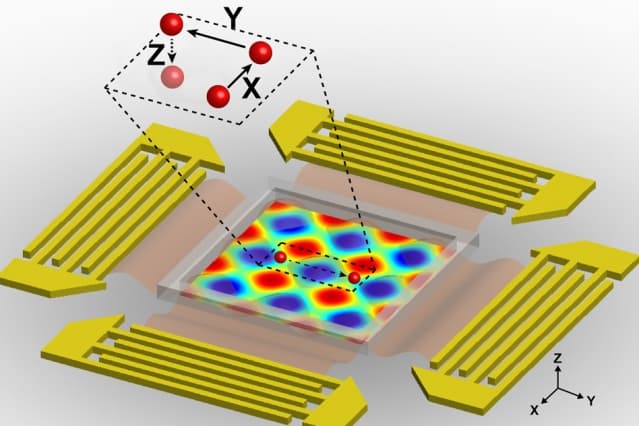Acoustic Tweezers Levitate Cells in 3D - Could Bring Better Accuracy In Tissue Engineering
Researchers at MIT have identified a new way to manipulate single cells and cell structures without damaging or disfiguring them. The cells are carried around in space by sound waves, thereby eliminating the need to handle them using solid objects. This technology could revolutionize 3D printing of human tissues, because this addresses the main problem; creating exactly the same skeletal structure of the tissue as the original human tissue. The research was in collaboration with Carnegie Melon University and Penn State University.
 The cells are moved in 3 dimensional space using sound waves. The scientists have employed the same microfluidic device they had used earlier to move cells in 2D. The device is capable of producing 2 standing waves of constant height or amplitude. A pressure node is created where the two waves from opposite directions meet, and it traps a single cell between them.
The cells are moved in 3 dimensional space using sound waves. The scientists have employed the same microfluidic device they had used earlier to move cells in 2D. The device is capable of producing 2 standing waves of constant height or amplitude. A pressure node is created where the two waves from opposite directions meet, and it traps a single cell between them.
Phase, wavelength and amplitude are the three properties of the waves which, when varied, carry the cell through 3D space. Earlier, in 2D manipulation, researchers had varied phase and wavelength only. The latest discovery is that, by changing the amplitude or the height of the sound wave, cells can be levitated along Z-Axis and placed wherever necessary. To demonstrate this, the team created patterns of numbers and alphabets using single cells they moved using the acoustic tweezers.
 This discovery is advantageous to a variety of branches, though neuroscience and tissue engineering will be greatly influenced. The success of a human tissue implant lies solely on the accuracy of the structure, but till now it was very difficult because cells could be damaged when touched. This acoustic tweezers technique helps scientists achieve that without having to handling the cells physically or chemically tagging them.
This discovery is advantageous to a variety of branches, though neuroscience and tissue engineering will be greatly influenced. The success of a human tissue implant lies solely on the accuracy of the structure, but till now it was very difficult because cells could be damaged when touched. This acoustic tweezers technique helps scientists achieve that without having to handling the cells physically or chemically tagging them.
The team behind this discovery have filed to patent this technology and are to take it further into tissue engineering and numerous other medical applications.
Source: <a href="https://news.mit.edu/2016/acoustic-tweezers-manipulate-cells-sound-waves-0125" target="_blank" rel="nofollow noopener noreferrer">Acoustic tweezers manipulate cells with sound waves | MIT News | Massachusetts Institute of Technology</a> | #-Link-Snipped-#

Phase, wavelength and amplitude are the three properties of the waves which, when varied, carry the cell through 3D space. Earlier, in 2D manipulation, researchers had varied phase and wavelength only. The latest discovery is that, by changing the amplitude or the height of the sound wave, cells can be levitated along Z-Axis and placed wherever necessary. To demonstrate this, the team created patterns of numbers and alphabets using single cells they moved using the acoustic tweezers.

The team behind this discovery have filed to patent this technology and are to take it further into tissue engineering and numerous other medical applications.
Source: <a href="https://news.mit.edu/2016/acoustic-tweezers-manipulate-cells-sound-waves-0125" target="_blank" rel="nofollow noopener noreferrer">Acoustic tweezers manipulate cells with sound waves | MIT News | Massachusetts Institute of Technology</a> | #-Link-Snipped-#
0
